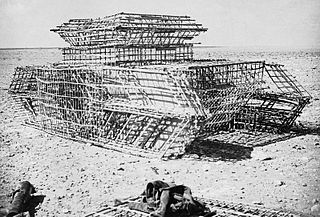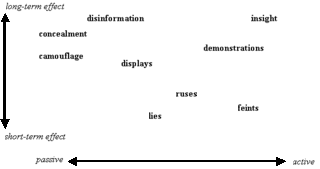
Operation Fortitude was a military deception operation by the Allied nations as part of Operation Bodyguard, an overall deception strategy during the buildup to the 1944 Normandy landings. Fortitude was divided into two subplans, North and South, and had the aim of misleading the German High Command as to the location of the invasion.

Psychological warfare (PSYWAR), or the basic aspects of modern psychological operations (PsyOp), have been known by many other names or terms, including Military Information Support Operations (MISO), Psy Ops, political warfare, "Hearts and Minds", and propaganda. The term is used "to denote any action which is practiced mainly by psychological methods with the aim of evoking a planned psychological reaction in other people".
During World War II, Operation Pastel was the U.S. deception plan scheduled to protect Operation Olympic, the planned invasion of southern Japan. Pastel would have falsely portrayed a threat of an American-led invasion against ports in China via attacks on Formosa.
The French ruse de guerre, sometimes literally translated as ruse of war, is a non-uniform term; generally what is understood by "ruse of war" can be separated into two groups. The first classifies the phrase purely as an act of military deception against one's opponent; the second emphasizes acts against one's opponent by creative, clever, unorthodox means, sometimes involving force multipliers or superior knowledge. The term stratagem, from Ancient Greek strategema, is also used in this sense.

Operation Bertram was a Second World War deception operation practised by the Allied forces in Egypt led by Bernard Montgomery, in the months before the Second Battle of El Alamein in 1942. Bertram was devised by Dudley Clarke to deceive Erwin Rommel about the timing and location of the Allied attack. The operation consisted of physical deceptions using dummies and camouflage, designed and made by the British Middle East Command Camouflage Directorate led by Geoffrey Barkas. These were accompanied by electromagnetic deceptions codenamed Operation Canwell, using false radio traffic. All of these were planned to make the Axis believe that the attack would take place to the south, far from the coast road and railway, about two days later than the real attack.

The Parachutist Badge, also commonly referred to as "Jump Wings" is a military badge of the United States Armed Forces. Some services, such as the Marine Corps, officially refer to it as an insignia instead of a badge. The United States Space Force and United States Coast Guard are the only branches that do not award the Parachutist Badge, but their members are authorized to receive the Parachutist Badges of other services in accordance with their prescribed requirements. The DoD military services are all awarded the same Military Parachutist Badge. The U.S. Army and U.S. Air Force issue the same Senior and Master Parachutist Badges while the U.S. Navy and U.S. Marine Corps issue the Navy and Marine Corps Parachutist Insignia to advanced parachutists. The majority of the services earn their Military Parachutist Badge through the U.S. Army Airborne School.

A Quaker gun is a deception tactic that was commonly used in warfare during the 18th and 19th centuries. Although resembling an actual cannon, the Quaker gun was simply a wooden log, usually painted black, used to deceive an enemy. Misleading the enemy as to the strength of an emplacement was an effective delaying tactic. The name derives from the Religious Society of Friends or "Quakers", who have traditionally held a religious opposition to war and violence in the Peace Testimony.

Military deception (MILDEC) is an attempt by a military unit to gain an advantage during warfare by misleading adversary decision makers into taking action or inaction that creates favorable conditions for the deceiving force. This is usually achieved by creating or amplifying an artificial fog of war via psychological operations, information warfare, visual deception, or other methods. As a form of disinformation, it overlaps with psychological warfare. Military deception is also closely connected to operations security (OPSEC) in that OPSEC attempts to conceal from the adversary critical information about an organization's capabilities, activities, limitations, and intentions, or provide a plausible alternate explanation for the details the adversary can observe, while deception reveals false information in an effort to mislead the adversary.

Military camouflage is the use of camouflage by an armed force to protect personnel and equipment from observation by enemy forces. In practice, this means applying colour and materials to military equipment of all kinds, including vehicles, ships, aircraft, gun positions and battledress, either to conceal it from observation (crypsis), or to make it appear as something else (mimicry). The French slang word camouflage came into common English usage during World War I when the concept of visual deception developed into an essential part of modern military tactics. In that war, long-range artillery and observation from the air combined to expand the field of fire, and camouflage was widely used to decrease the danger of being targeted or to enable surprise. As such, military camouflage is a form of military deception in addition to cultural functions such as political identification.

Operation Zeppelin was a major military deception operation run by the British during the Second World War. It formed part of Operation Bodyguard, the cover plan for the invasion of Normandy in 1944, and was intended to mislead German intelligence as to the Allied invasion plans in the Mediterranean theatre that year. The operation was planned by 'A' Force and implemented by means of visual deception and misinformation.

Dummies and decoys are fake military equipment that are intended to deceive the enemy. Dummies and decoys are only one aspect of military deception.

Operation Titanic was a series of military deceptions carried out by the Allied Nations during the Second World War. They formed part of tactical element of Operation Bodyguard, the cover plan for the Normandy landings. Titanic was carried out on 5–6 June 1944 by the Royal Air Force and the Special Air Service. Its objective was to drop hundreds of dummy parachutists, noisemakers and small numbers of special forces troops in locations away from the real Normandy drop zones. It hoped to deceive the German defenders into believing that a large force had landed, drawing troops away from the beachheads and other strategic sites.
Russian military deception, sometimes known as maskirovka, is a military doctrine developed from the start of the 20th century. The doctrine covers a broad range of measures for military deception, from camouflage to denial and deception.

The Ghost Army was a United States Army tactical deception unit during World War II officially known as the 23rd Headquarters Special Troops. The 1,100-man unit was given a unique mission: to deceive Hitler's forces and mislead them as to the size and location of Allied forces, while giving the actual units elsewhere time to maneuver. Activated on January 20, 1944, the Ghost Army arrived in Europe in May shortly before D-Day and returned to the US at the end of the war in July 1945. During their tenure, the Ghost Army carried out more than 20 deception campaigns, putting on a "traveling road show" using inflatable tanks, sound trucks, fake radio transmissions, scripts and pretense.

Dummy tanks superficially resemble real tanks and are often deployed as a means of military deception in the absence of real tanks. Early designs included wooden shells and inflatable props that could fool enemy intelligence; they were fragile and only believable from a distance. Modern designs are more advanced and can imitate heat signatures, making them more effective illusions.

Lieutenant Colonel Victor Harry Jones OBE was a British intelligence officer and "visual deception" expert during the Second World War. First serving with the 14th/20th King's Hussars in the First World War, he made a name for himself during the North African campaign of the Second World War by using dummy tanks to mislead the enemy. In 1941 he was transferred to A Force in Cairo, under Dudley Clarke, to continue deception operations on a larger scale.
The 1st Special Air Service Brigade was a fictional brigade during the Second World War. It was first formed in Cairo in 1941, as part of a deception by Brigadier Dudley Clarke, to play on Italian fears of airborne attacks. Clarke used documents, photographs, news reports and even fake SAS soldiers to plant information about the brigade – he even named the Cairo-based deception department, 'A' Force, to bolster evidence of their existence.

The British Middle East Command Camouflage Directorate organised major deception operations for Middle East Command in the Western Desert Campaign of the Second World War. It provided camouflage during the siege of Tobruk; a dummy railhead at Misheifa, and the largest of all, Operation Bertram, the army-scale deception for the decisive battle of El Alamein in October 1942. The successful deception was praised publicly by Winston Churchill.
Advanced Headquarters 'A' Force, generally referred to as 'A' Force, was the name of a deception department during the Second World War. It was set up in March 1941 and based in Cairo under Brigadier Dudley Clarke. General Archibald Wavell, the commander of forces in North Africa at the outbreak of war, initiated the use of deception as part of Operation Compass, in December 1940. After the success of Compass, Wavell sent for Clarke, with whom he had earlier worked in Palestine. Clarke was charged with forming the first deception department, in secret with limited resources.














